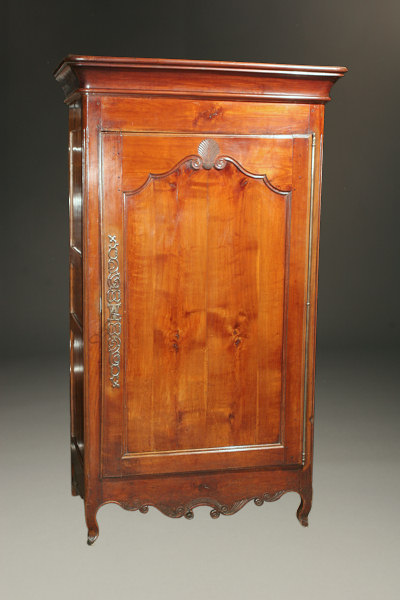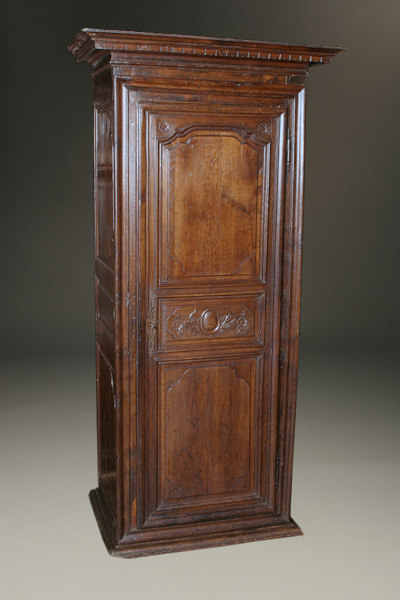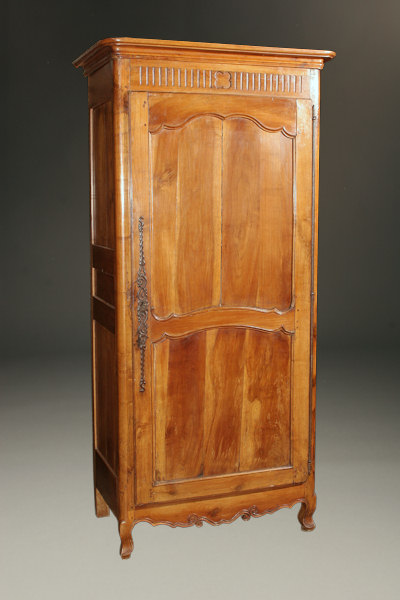We at Beauchamp Antiques thoroughly enjoy the history behind antiques, and bonnetieres are a great example as to why. These lovely French furniture pieces came into existence in the mid-eighteenth century in response to women’s elaborate hairstyles of that time period. The large hats, wigs and other apparatuses (think the movie Amadeus) that were in vogue required tall, slender storage options—hence the birth of bonnetieres.
Although bonnetieres were created for an intended purpose, the French found they were wonderful storage cabinets for anything, making the pieces even more popular. We find them in the country French Louis XV and Louis XVI styles, though we have come across some in Henry II, Louis XIV and Louis Philippe designs as well. Their clean lines and subdued décor makes them popular pieces today.
Bonnetieres are often compared to armoires, as they have similar designs. Bonnetieres are smaller than armoires in all ways but one—they are no shallower. These pieces are very deep for a small piece of furniture, as that depth was needed for the wild hairdos! Most bonnetieres have three shelves. In general, the interiors of eighteenth-century country French armoires and bonnetieres are often much less finished than the exteriors. Perhaps the tremendous effort the cabinetmakers put into the outside of these pieces left little resources for the insides beyond quality construction. As provincial pieces, bonnetieres were often made out of native woods like cherry, walnut, oak and chestnut.
Here are a few examples of the antique bonnetieres in our collection:

This lovely cherry bonnetiere pictured above features classic styling, with an iron escutcheon that is beautifuly patinaed, and a gun barrel hinge. The delicate cabriolet legs are a common feature of Louis XV country French cabinetry. The scrolled molding along the top of the door terminates into a shell-patterned carving, and we find scrollwork on the bottom of the piece as well. The cornice features a half-round shape that protrudes into a prominent coved mold. It is rare to see such effort put into the crafting of such a strong cornice! The piece is built in the typical eighteenth-century mortise and tenon with wood peg construction.

Circa eighteenth century, the piece pictured above features clean, geometric lines that create a country feel. Unlike many of our other pieces, there are no flowing legs or intricate scrollwork that create a more delicate look. The wide crown molding makes this more slender bonnetiere seem more substantial. On this piece, the stacked moldings that create the cornice are indicative of the Louis XIV style. It may surprise you to know that this piece is made out of oak. Many Americans are used to the lighter, golden oak we find in the States. However, European oak has more tannic acid in it, giving it a darker look, particularly in the old growth lumber. Eighteenth and nineteenth-century Europeans held oak in high regard. It is a hard wood, making it difficult to hand tool yet durable for everyday use. When a craftsman took the effort to create a piece out of oak, they were proud of it! The natural dark color would be enhanced with stains, which more often than not would give the piece the tones of walnut.

Circa 1780, the piece pictured above features rich cherry wood, cabriolet legs, scroll work at the bottom, and fluted carvings above the door that lead into a center quatrefoil. The molding in the center of the door is quite attractive with its slight arch. The cabinetmaker created the doors out of cherry boards with exposed sapwood. You may have heard of heartwood, which is the inert, inner part of a tree, and is usually darker than the outer part of the tree. This outer part is referred to as the cambium layer, where the tree cells have not yet died. Sapwood comes from this live layer, and is typically lighter in color. The use of the sapwood gives this piece a less formal look and more character than one made out of heartwood. Another interesting note: the lumber for this piece was pit-sawed, which is a method of creating boards from a tree by laying the log over a hole. A junior timber man would jump into the pit and, working with a timber man above, pull the saw down and up to form the boards. Needless to say, pit sawing was laborious work, so every piece of lumber was highly valued, including the sapwood!
Today, homeowners love bonnetieres for their versatility, using them for anything and everything in any room! Europeans started using them for many purposes in the nineteenth century and their functionality still holds true today. We have seen bonnetieres used in bathrooms, kitchen, entryways, small areas in a great room, bedrooms—anywhere beautiful storage is needed. There is no better piece of furniture for filling a niche in large room or for making a small space more functional.
